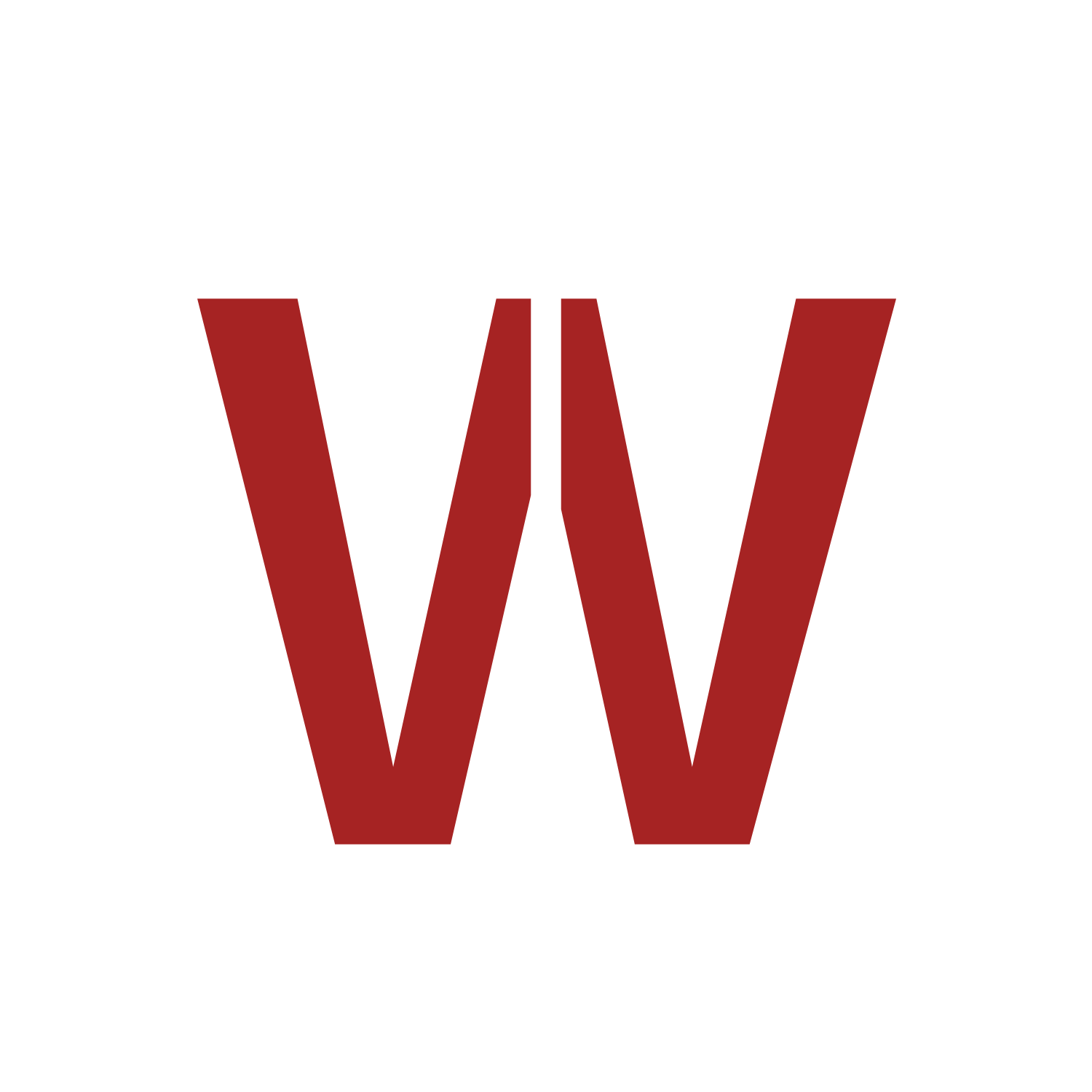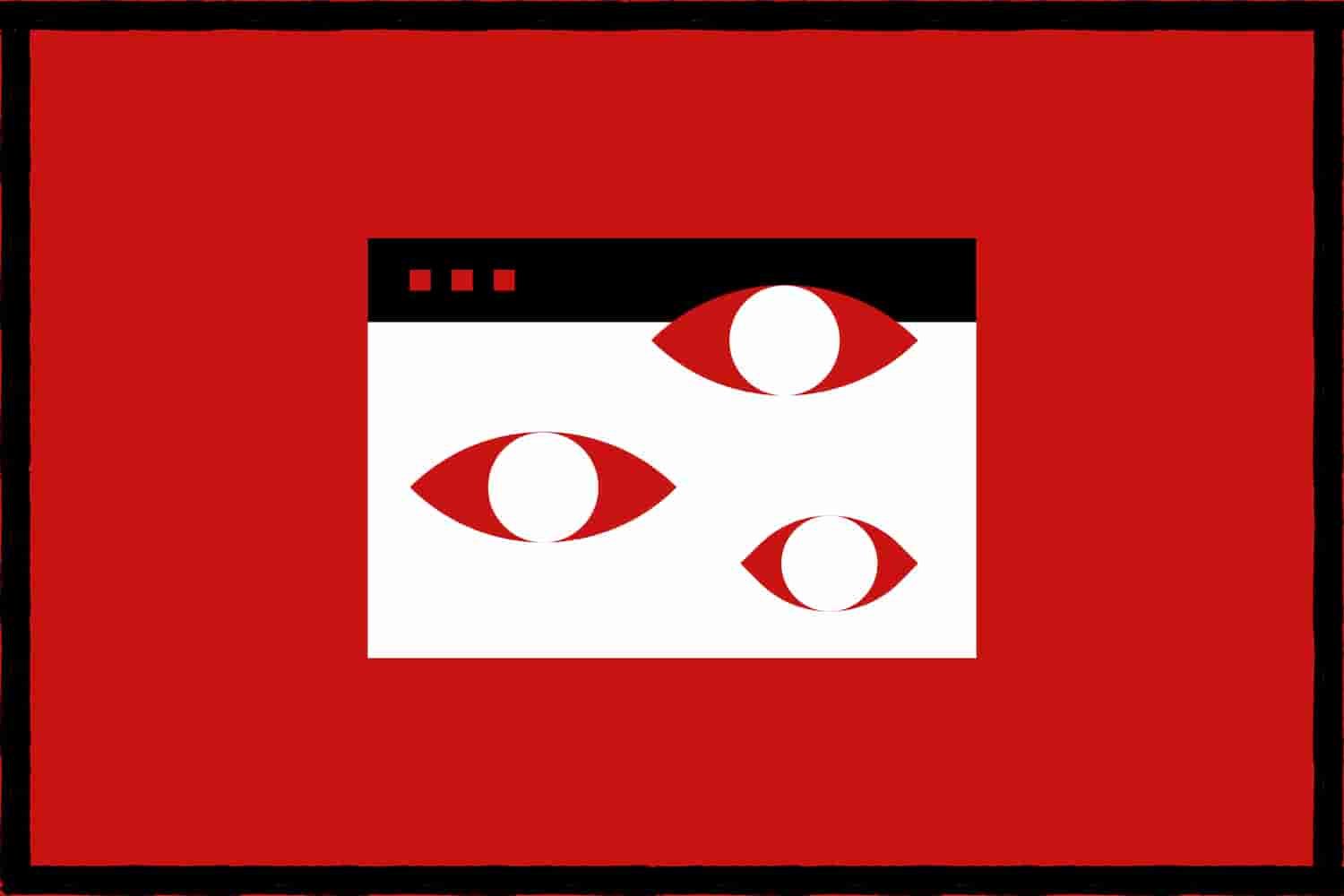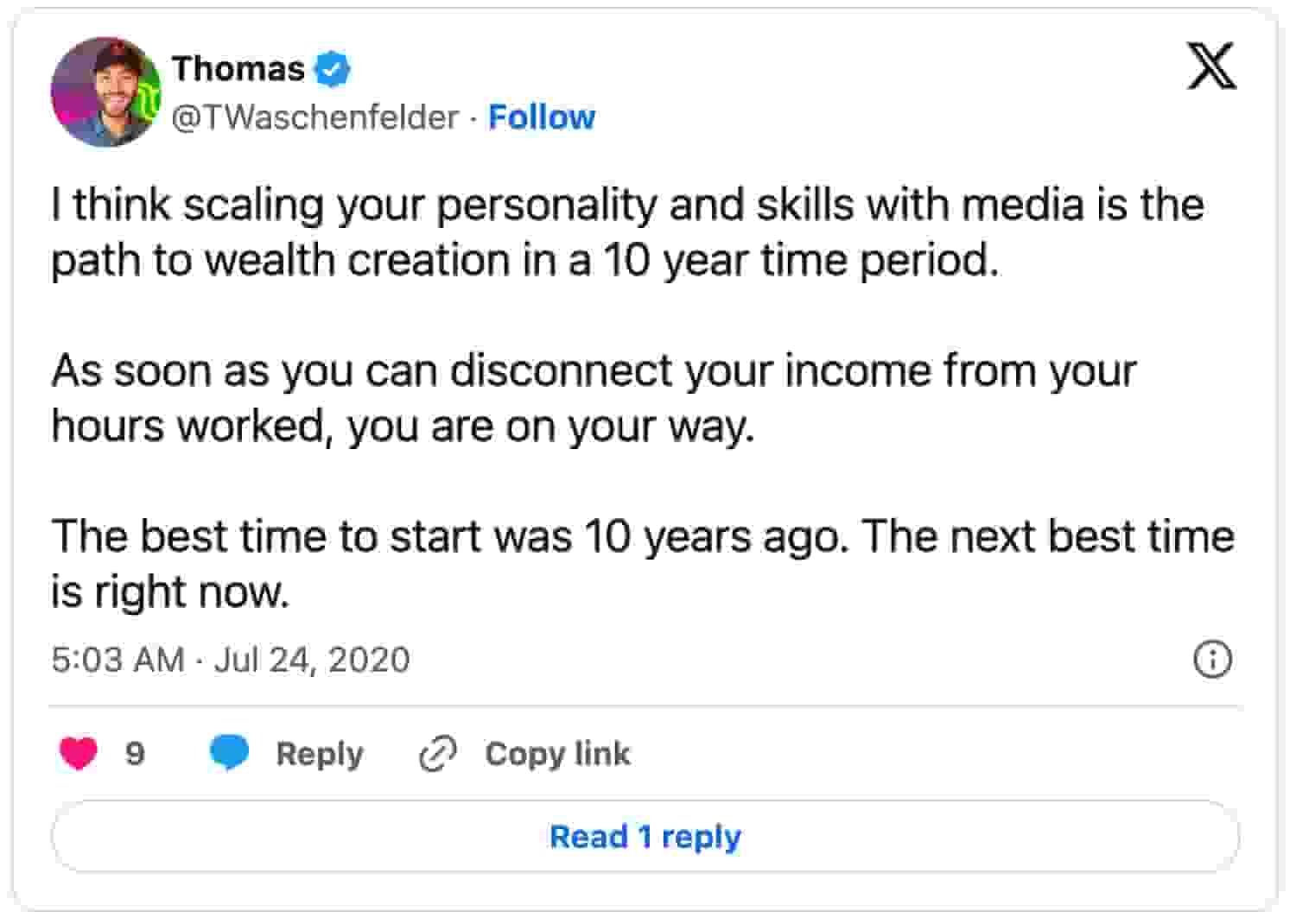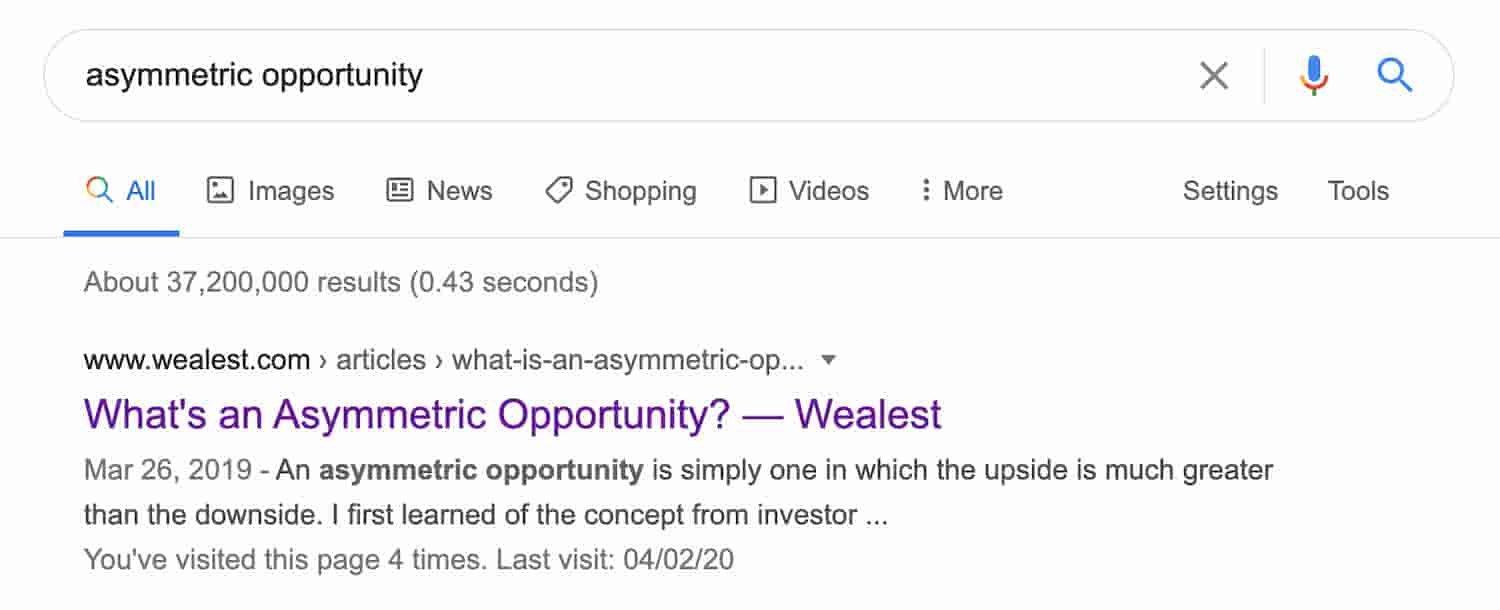Build An Audience, Then Sell Them The Product Or Service They Want
The ability to produce and scale media online has created an unprecedented opportunity for non-technical "creatives" (writers, artists, performers, visual designers, etc.) to build and monetize an audience.
For the average person, this is the most accessible path to wealth creation in their 20s, 30s, and 40s.
Investing in the stock market, real estate, etc. will create wealth over the longterm (20-40 years). And you should absolutely invest in these kinds of assets.
But in the short term (5-10 years), building a platform to scale your ideas to an audience and then monetizing that audience with products they want is a very viable route. And the risk is low to get started. You only need a little bit of money to build your platform, and the rest is upside.
This is the path I've chosen and one I'm documenting in real-time for you on this site. Here's the path as I see it:
Choose A Platform To Build On.
The platform you choose is dependent on the medium you create in.
If you're a photographer or visual designer, Instagram is a great place to start. If you're a writer, then your own blog and a strong presence on Twitter maybe your first moves. If you're a videographer or actor, then YouTube is where you should build.
I started scaling my ideas through writing. I have three main platforms:
Squarespace
Mailchimp
Twitter
Squarespace hosts this site. I chose it because it's relatively easy to learn, and has a built-in "blog" function that makes writing and publishing content intuitive. Mailchimp handles my weekly Quick-Reads newsletter, which is also writing based. And Twitter is a natural complement for any writer because it's a word-based platform with 280 characters per tweet.
What's impressive about Twitter is that the algorithm helps you scale your ideas. You can start Tweeting and almost immediately begin to get impressions (the number of times people see your tweet) and profile visits (the number of people visiting your profile).
I recently wrote about the power of Twitter to scale your personality - you can read that article here.
You Don’t Need A Technical Background To Build.
The best thing about these platforms is that you don't need any kind of technical (coding) background to build on them. I didn't have one when I started, and I still don't.
For example, you can be up and running on Twitter in less than 10 minutes with very little technical knowledge. It will take a little longer to build a custom Squarespace site yourself, but nothing crazy. It took me about three weeks to make this version of Wealest.com, and it hasn't had a significant overhaul since it went live (even though it probably needs one!).
Squarespace has loads of built-in templates. Once you know the design basics, you can make big changes quickly. Or, you can just pay someone else to build it for you and focus on creating and publishing your work.
There Are No-Code Platforms For Almost Everything.
If you can imagine it, there is probably a software already built that does it for you.
For example, Mighty Networks is a platform that lets you to build entire forum communities around your content. You can even create custom courses (video and written) for your audience to purchase.
Substack let's independent writers make a living off their writing with a newsletter / subscription package.
And Canva lets graphic designers build almost any design from scratch or pre-built templates.
You don't need to know how to code - just choose software and start creating.
You Can Expand Your Platforms Over Time.
I do recommend starting with just one or two platforms to make it easier to publish consistently. But you can always expand your platforms over time.
While I only have three main platforms right now, mostly text-based, I plan on adding Instagram, YouTube, and a Podcast in the next year.
Publish Consistently.
To build an audience, you need to publish. What kinds of stuff should you post?
Pick A Niche You’re Interested In Learning More About.
You've probably heard the phrase, "write what you know." This is wrong (mostly).
Yes, you should always try and filter ideas through your unique experience. But that doesn't mean you can't just create content about the cool things you're learning in a particular field.
That's where I started. Wealest was born out of my hunger to learn the ideas of wealth creators. I didn't know anything about wealth creation before 2016. I just read a lot, filtered those ideas through my unique personality, and wrote about it.
So, pick something you're interested in and want to learn more about. Then create content around what you learn and how it applies to you.
Production Is Better Than Perfection.
Your first piece of content probably won't be great. That's ok!
When you publish consistently, you'll get feedback on what works and what doesn't. This will make your work better over time. Here's what that looks like:
Create → Publish → Get Feedback → Iterate → Publish → Get Feedback → Iterate → Publish … and the cycle continues.
The key is to keep publishing despite feeling like your work is not good enough. Production is better than perfection. You will get better.
How Often Should You Publish?
It depends on what you're creating. I publish one long-form blog post a week, and it takes me about 5 hours from beginning to end. My newsletter also goes out once a week and takes about an hour.
You don't need to dedicated 20 hours a week to creating stuff and publishing. Find a pace that works for you, and stick with it. Consistency is the key.
The Media You Create Has a Zero Marginal Cost of Reproduction.
Internet media has a critical intrinsic characteristic that creates an enormous opportunity for creators: there's no marginal cost to reproduce it.
Whether one person reads this article, or one million, the cost for me to write it is the same (about 5 hours of my time). Then it scales without any cost of reproduction on my end to anyone with an internet connection. I write it once, and can then "ship it" to anyone around the world for free. This is the power of internet media.
Build an Audience of Like-minded Followers.
No matter what you're interested in, there's someone else who's interested in the same thing you are. That's the incredible power of the internet. So, how do like-minded people find your work?
Google Search
Google Search is the most effective way to get traffic to your content. Once you start publishing consistently, Google will begin to rank you in their search results. Be warned: it takes a long time (six months to a year) to start ranking consistently. But it's well worth it.
Here's an example from my site: go search "asymmetric opportunity" on Google. What's the first result?
That’s the power of search engine optimization.
Social Media
You’ll get more traction quickly on social media if you’re producing cool stuff, but the traffic is less consistent. With social, it’s a numbers game - the more you post to Twitter, Facebook, Instagram, etc. the better your chances of going viral and getting more followers / visitors.
So post frequently - more than you think you should. I post about ten original tweets per day using Hypefury, racking up hundreds of thousands of impressions.
Direct Visitors
These are people who actively seek out your content by navigating to your site. As people get introduced to your work through social or Google search, some of them will become dedicated followers - these are your direct visitors.
Build a Database of Engaged Readers.
This is critical. You must allow interested followers and readers to join your newsletter. Your newsletter becomes your database of highly engaged visitors - those who will guide you in your product creation later on.
So start a newsletter. Mailchimp offers it for free for customers with less than 2,000 subscribers. Speaking of which…
Join My Newsletter
Traffic For Wealest.com
Here’s a breakdown of my visitors over the past year:
Current as of 07/23/2020
Google search search makes up the bulk of my traffic, with direct traffic coming in second. The “other” category is mostly Twitter.
If you publish consistently and keep pushing content out, you’ll get traction in all these areas.
Create a Product Or Service Your Audience Wants And Sell It To Them For a Fair Price.
Once you have some traction with your audience in a specific niche, nothing is stopping you from building a product or service your audience wants and selling it to them for a fair price.
How do you know what they want? Ask them! Run a poll on social media, ask your newsletter readers what kind of product or service would be useful, or just offer something you would find helpful and see what feedback you get.
Here are some products or services you could create:
“How To” Video Series
Software Product
Project Template
Physical Product
Community Membership
E-Books or E-Guides
Paid Newsletter
Design Service
Video Production Service
Copywriting Service
The list of products you could sell is endless. If you can clearly demonstrate the value of your product, price it fairly, and it’s something your audience wants, you’ll start making ethical sales.
You Own Equity In The Products You Build.
Equity is just a fancy word for owning a piece of a business or product. It’s the single most crucial part of wealth creation. You will not get rich working for an hourly wage - you must own equity.
When you build a product and sell it, that’s a piece of equity that can make you money while you sleep.
Naval Ravikant explains that equity decouples your inputs from your outputs. So does a product. It disconnects the inputs (time, creative energy, etc.) from the outputs (money). You can build a product in 20 minutes that makes you $1,000. Or you can spend a year creating something that makes almost nothing. If you are going to get rich, this is the kind of positive Black Swan environment you want to be operating in.
Further, your product is working for you every second of every day to find you sales. It’s scalable, so you only have to build it once, but you can sell it to anyone with an internet connection.
Offering a service is not as attractive as providing a product because, with a service, you are still exchanging time for money. Ideally, you can drop service that service and take a cut of the transaction. This boils down to “get paid by the project, but payout by the hour.”
Build products to build equity and make money while you sleep.
People Buy Because They Trust You, Not Because You Offer The Only Solution To Their Problem.
A lot of people think they can’t sell a certain product because someone else is already selling it. Not true!
All of the content you’ve been creating for free has built trust between you and your audience.
That’s why when you create a product they want that solves a problem and provides value, you will make sales. It doesn’t matter if someone else also has a solution to the problem. Your audience will buy your version of the solution because they trust you.
Create Content → Build an Audience → Sell Them Something They want.
This process is simple but not easy. I’ve published an article every week for 60+ weeks, and I’m just starting to see serious traction. It takes time, discipline, and patience. But you can do it. I know because I did it without any technical background and no experience building an audience.
The best time to start was ten years ago. The second best time is now.







